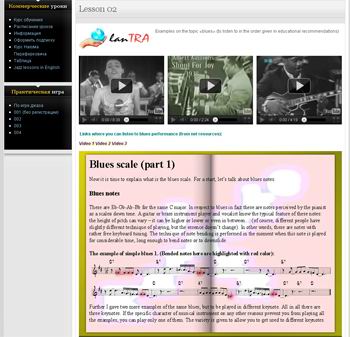
Уроки
Blues scale
- Подробности
- Категория: Уроки теории
 See full version of this jazz lesson (get link)
See full version of this jazz lesson (get link)
Now it is time to explain what is the blues scale. For a start, let’s talk about blues notes.
Blues notes
These are Eb-Gb-Ab-Bb for the same C major. In respect to blues in fact these are notes perceived by the pianist as a scaleв down tone. A guitar or brass instrument player and vocalist know the typical feature of these notes: the height of pitch can vary – it can be higher or lower or even in between… The technique of note bending is performed in the moment when this note is played for considerable time, long enough to bend notes or to downslide.
The example of simple blues 1. (Bended notes here are highlighted with red color):
If the specific character of musical instrument oк any other reasons prevent you from playing all the examples, you can play only one of them. The variety is given to allow you to get used to different keynotes.
Example in Eb:
Example in F:
And one more example of simple blues:
And in other keynotes:
Example 2 in Bb:
Example 2 in Ab:
These notes are not always used to downslide or as bended notes – in other cases (in fast beat also) they are full members of the blues scale family with strict keyboard tuning; and for the instruments with keyboard tuning system this is the only possible variant. We scratch our head and understand that in blues 3, 5, 6 and 7th scale tone can be played (sung) both ways (it is possible to vary the way you play). Besides, depending on the situation, natural and descending scale tones can be used in blues.
Example 3:
Example 3 in G:
Example 3 in F:
Despite this situation with the blues scale (it can be explained by the fact that thirds of the main functions (T.S.D.) vary) we to prevent misunderstanding will agree upon the statement that blues scale is a scale with alternative (descending) thirds of main functions (not obligatory three all together). And we will have a clear idea that the blue scale represents the alternative (something like a mirror) to the main Ionian scale. It is evident that these two scales exist together. The contrast of these two scales can provide us with interesting melody line.
There are many examples of the use of blues scale as the mirror of Ionian scale in the compositions «boogie-woogie» (see videos 1, 2). Moreover, in harmony in most cases of scales contrasts functions of the 1st and the 4th scale tones are used (for information - boogie-woogie also has the blues form). As for me, I have prepared for you the music piece “Blue Trombone” where the theme and the majority of improvisation is based exactly on this technique (see the tasks).
But all this is for three simple functions in harmonization.
In case of more difficult variants of harmonization and deviations or substitution of functions the grade of variation may be limited by the necessity to choose low or natural scale tone, but even in this case the general scale (theme) will contain both scale tones – otherwise there is no blues.
1. Modern blues can comprise all 12 half-tone of tempered gamut in one composition (which was to be proved.)
2.Blues notes are on all other sounds absent in the scale tones of the Ionian scale (for C major these are correspondingly all black piano or accordion keys.) Blues notes on their own also form the pentatonic scale (I just wanted to mention it, there is no practical use in it.)
The task is to find blues notes in three keynotes: Eb, Bb, G.
Blues composition.
At the first lesson I showed the standard blues chord symbols. Of course, there are endless variants of blues composition based on the harmonious net as well as on the inner structural composition.
This was the example of the really famous West Coast Blues with the metric signature 6/4 that affects the theme and improvisations. Two variants of chord symbols are given.
Here is West Coast Blues in two keynotes for adaptation and training:
In C:
You can listen how this composition was performed by Wes Montgomery. Video example № 3.
One more time we will speak about the variety of blues composition. Pay attention to the examples where the poetic line is not at all connected with the 12-bar blues form. See links on YouTube videos (the video is below).
Thus, we should bear in mind that there are deviations from the traditional blues (varying according the amount of bars), but still we will concentrate our attention on the traditional variant (this variant is easy to play as there is no need to discuss the form deviations). So, we will study and play the traditional variant.
And now let’s discuss the variants of melodic and harmonious blues composition.
First of all, it is hardly possible to limit blues to only one pentatonic scale.
Secondly, in blues the Ionian scale and several blues pentatonic scales coexist.
Thirdly, in blues chord symbols tend to be more and more difficult and beat conflicts are typical for blues. The narrative philosophy is represented by the same material (Nahum Pereferkovich refers to it as «mantra»), but this material tends to become more and more difficult and expressive, and I would say that this music calls for dialogue and even dispute. If you are attentive, you will notice that not only keys are frequently repeated, but also phrase and sentences. All this is present in blues alongside with the beat that is the same in all cases (and unites everything) – this is exactly what should bring listeners to the state of trance (that is the reason jazz is appreciated).
When the bebop was the main style of jazz the main blues scheme could have looked like this:
The use of the technique of deviations and different substitution lead to unimaginable variety of harmonious blues compositions. In frames of this course for the beginners it is early to speak about it.
I will give only one example from our anthology
Cool Blues (Charlie Parker):
Modern blues may contain many variants of pentatonic scale, the whole chromatic spectrum of sounds; it can be played in minor oк in major of in both; it can be modulational or even atonal.
But we will still recognize it due to its 12-bar poetic line and the variety of main functional thirds in a melody.
To reinforce the material of this lesson, to make the said above more vivid and just for pleasure it is the right time to pass to the practical part – to playing blues. Use links and navigate through menu.
The next lesson will be dedicated to: blues scale (part 2).



